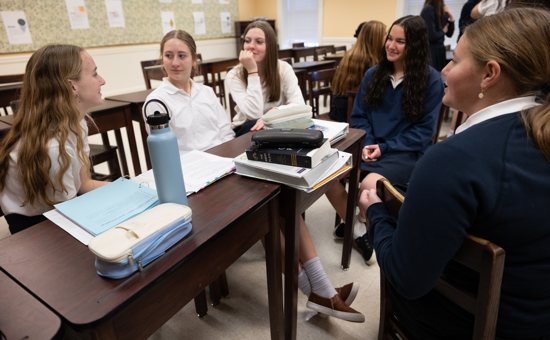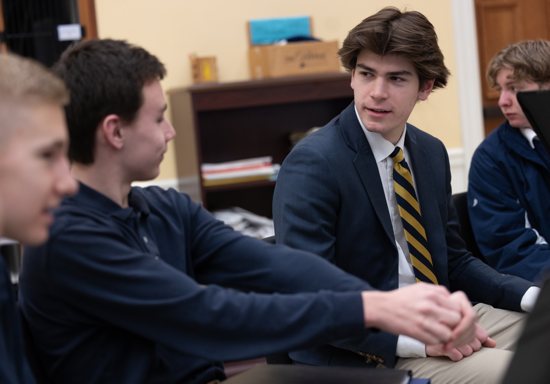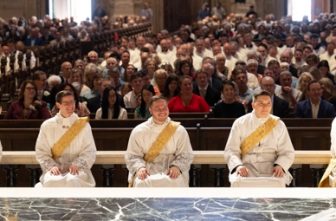
To nurture a sense of community, foster relationships, provide a supportive network and establish a place of belonging, several Catholic schools across the Archdiocese of St. Paul and Minneapolis have embraced the “house system,” reminiscent of the traditional British-based system that provides students the opportunity to connect across grades and classrooms.
Providence Academy in Plymouth opened in 2001 and at that time, the school did not have a house system. In the fall of 2006, Edward Hester, history teacher in Providence’s Upper School, was a new hire and he proposed the house system to then-Upper School Director Kevin Ferdinandt.
“The house system proposal from Mr. Hester came from his own school experience at St. Benedict’s Prep in Newark, New Jersey, which has been featured on ‘60 Minutes’ and other major media outlets for their successful house system,” said Kurt Jaeger, upper school director at Providence Academy. “While our house system is not identical to theirs, it has many similar elements and a similar goal of building culture and community.”
Providence’s single-gender houses consist of students in grades nine through 12. Students stay in the same house all four years, allowing them to build bonds of brotherhood and sisterhood, and houses welcome new freshmen every year. The 10 male and 10 female houses are identified by Greek letters and a saint, so each house has a feast day. The house identifiers do not change so that Providence alumni can continue to identify with their house after graduation. Each house has a faculty leader, who defers to the student leaders to manage house activities but is there to provide adult supervision.
Providence’s uniform dress code is intended to create a community spirit while focusing on the student as a unique person. As students move from middle school to the upper school at Providence, the required uniform and grooming standards change, so at the start of the new school year, the house system also provides an opportunity to ensure students understand the requirements.
Each fall, Providence hosts a ceremony with the upper school student body during which house leaders induct new members from the ninth-grade class. These students are assigned in advance by administrative staff based solely on having an even distribution of students in each house.
“After induction, each house meets every morning for a homeroom of sorts where students pray, offer intentions, do announcements and often check in on initiatives they have for their community,” Jaeger said. “In addition, houses meet every Wednesday for 50 minutes for activities.”
Those activities include large group convocations to listen to a group speaker, celebrations of school achievements, service opportunities and academic support. There are a series of fun activities including pumpkin carving, sled races and decorating gingerbread houses. There are tournaments between houses that include competitions such as flag football and dodgeball. There is doorway decorating for Halloween and Christmas and a Thanksgiving food drive. These activities earn house points and Providence awards a house cup each year to the house that’s earned the most points.
CATHOLIC SCHOOLS WITH HOUSE SYSTEMS
- St. Francis Xavier School Middle School, Buffalo
- Chesterton Academy, Hopkins
- Holy Family Academy, St. Louis Park
- Providence Academy, Plymouth
- St. Agnes, St. Paul
- St. Croix Catholic, Stillwater
- St. Hubert, Chanhassen
- St. Joseph, West St. Paul
- St. Thomas Academy Middle School, Mendota Heights
- Visitation School Upper School, Mendota Heights
“Providence Academy’s house system embraces camaraderie, leadership and a positive atmosphere within our community,” said Joe Spades, a senior and a male house captain. “My favorite part about house is being able to meet guys of various grades, where I otherwise would not have been able to. I love planning all the events and trying to raise school spirit while I do so. Leading a house is a great honor for me and was something I strived for as an underclassman. I was selected by my peers, and I never want to let them down.”
Providence female house captain Rachel Bartels said having a house system provides students with a close-knit community of fellow students.
“Praying together each morning also builds our house into a spiritual house,” Bartels said. “House is a place where students can make friends with classmates as well as those in other grades they wouldn’t have necessarily gotten to know personally before. That is one of my favorite things about our house system.”
As the leader of her house, Bartels has made it a priority to get to know each one of the girls.
“Growing friendships throughout each grade is so important. I remember being a freshman and looking up to my house leader at that time. She and many others in my house were like big sisters to me, and guided me through being new to high school,” Bartels said. “My goal is to create that same sisterly bond in my current house and to help the other girls feel like they have a home away from home. Leading a house at Providence Academy means fostering friendships and helping others grow in their journeys with the Lord.”
Building camaraderie
When Mary Carson — middle school science teacher and leader of the house program at St. Joseph Catholic School in West St. Paul — started at the school three years ago, the school’s house system was in the first stages of conception. The school had just moved to mixed grade-level homerooms. Each teacher picked a patron saint and slowly began to build crests and identity with the students in their homerooms.
In July 2023, St. Joseph brought in Brian Sinchak from Lakewood Catholic Academy (LCA) in Cleveland to plan the school’s house program through a workshop with grant funds received from the Catholic Schools Center of Excellence (CSCOE).
“Brian had seen great success in LCA’s house program, and it gave us many ideas for how we could build our program and incorporate it here at St. Joseph’s Catholic School,” said Kyle Rickbeil, principal.
“The purpose of our house system is to meet the needs of our students in more holistic ways: to build community, connection across disciplines, form virtuous people, and to breed joy,” Carson said. “We are about the Catholic vision: a holistic and universal scope to learning. We are whole persons: body, mind, soul and heart and our learning intersects beyond the boundaries of our classroom walls. Our unofficial house mission statement states: ‘St. Joseph House Program exists to inspire hearts, form virtue and build community.’ The motto we start each house event with is: ‘St. Joseph middle schoolers are courageously charitable and joyful persons of integrity.’ We do all that we do within our house program to make these two statements true.”
During Carson’s second year at the school, middle school staff members brainstormed the virtues that they wanted students to leave St. Joseph with: The resulting virtues were joy, courage, integrity and charity. These virtues laid the foundation for St. Joseph’s house program — becoming the names of the houses: Alegria (Spanish for “joy”), Ujasiri (Swahili for “courage”), Ionracas (Gaelic for “integrity”), and Carita (Italian for “charity”). The staff members also developed mottos, crests, mascots, colors and spirits of each house.
St. Joseph’s house system has four meeting structures: an event convocation during which students compete for points (four square tournaments, quiz bowl, the Great St. Joseph Bake-off, etc.); house meetings, following the responsive classroom model that involves discussing a topic or completing a task; a formation convocation during which students hear a brief teaching or example and apply it through simple activities and reflection; and a service and buddy event during which students complete a work of mercy with their elementary school buddies.
“At the start of a middle schooler’s experience at St. Joseph’s, they are sorted into one of our houses by reaching into ‘St. Joseph’s toolbox’ to grab a carabiner with the color of one of the houses (red, yellow, green or blue),” Carson said. “The carabiner symbolizes the connection and community that we built and lends itself to the mountain image — that we are headed somewhere epic, together. Once students are sorted, they stay in that house for all three years.”
Every employee at St. Joseph parish and school also is sorted into one of the school’s four houses. The middle school teachers and specialists act as house guardians (or leaders) of each house.
“The teachers are a huge part of making our program work, especially since we are in our early years of adopting the program,” Rickbeil said. “The teachers’ excitement really gets the students excited. As an example, our house program ends each year with a House Cup, in which students compete in a number of ‘field day’ challenges in one afternoon of final competition.”
The final House Cup challenge is a lip sync battle, in which students go on stage and perform a song for the rest of the middle school.
“Last year, all of these songs involved the teachers who were moderating each house, which to me was a great sign of ownership and humility from each of our teachers,” Rickbeil said. “It was amazing to see.”
Carson said St. Joseph’s house program has been successful because it meets the needs of the entire school.
“Education cannot simply be an input/output system but a human experience of encounter, engagement and adventure. Students desperately desire to be known and belong and to build mixed-grade level relationships. We do that,” Carson said. “Students need to be challenged and learn to lead others well. We do that. It provides the faculty to step into relationships with students as mentors and active agents in the formation of our young people.”
St. Joseph eighth grader and house leader Madeleine Hamiel said she thinks it is important for students to have a chance to provide input on the day-to-day life of the school and have a chance to change the school for the better.
“An aspect of house I enjoy is the monthly competitions,” Hamiel said. “These competitions give students a chance to take a break from traditional schoolwork and step into a new element they may not have realized they enjoyed.”

Working toward a common good
St. Hubert Catholic School in Chanhassen initiated its house system for the 2022-2023 school year to bring more Christian community to the school across grade levels, and to involve the teaching and support staff in the process. It was also geared at giving more leadership opportunities to middle school students.
“The goal of the house system is to promote Christian community across the school, regardless of grade level, academic or athletic ability, popularity, or other factors that people often use to separate themselves from others,” said Erich Hoffer, head of school at St. Hubert. “It also promotes teamwork, or a ‘we before me’ attitude, knowing that we are better together. Finally, it provides mentorship opportunities throughout the school for students that might not otherwise have the opportunity to work with and for others.”
At St. Hubert, students are assigned to one of the school’s nine random houses when they enter the school community. That way, Hoffer explained, each person in the house is welcomed as a valuable member and their assignments are based merely on the fact that they are persons of dignity who are now members of the school community.
There is a ceremony each year during which students are sorted into their houses and each house has a cheering section for their new members. Houses meet at least once a month and this usually surrounds an activity, contest or service project. Every faculty and staff member is included in the house system and mentors and leaders of the house work with middle school students to make sure all students are included. They are also the liaisons for the administration for all activities and contests.
“We compete for points in each activity based on cooperation, respect, project completion and following our school’s virtues in action,” Hoffer said. Points are awarded by the administration for each activity.
“We believe that the house system has been successful because it includes everyone in the building, working together for the common goal of Christian community,” Hoffer said.
Leadership opportunities for middle school students improved dramatically through greater opportunities in the house system, Hoffer said. The system has brought students together into a family of students and staff, and students know they are part of something bigger than themselves, he said.
“Our faith is incorporated into each activity and house crest, motto and values, so that Christ remains at the center of all that we do,” Hoffer said.
INSIGHTS FROM JOSEPH’S STUDENTS
“Especially as a sixth grader I found it (the house system) able to provide a place where I can meet seventh and eighth graders.”
– Will Dwyer, sixth grade
“I think the benefits of a house system are bringing people together, to strengthen our culture, and to have fun. I personally like the house games and competition.”
– Henry Lauth, sixth grade
“I think the benefits are that kids get to join together and have fun and learn about the saints and do fun activities. I enjoy getting to know other kids that I do not usually talk to. I also enjoy playing fun games and learning about God through the saints.”
– Josie Rogers, seventh grade
“As a leader, I think that we should try to come together and just have a fun time doing it. Leading my house is super cool because you are representing (the students). I was voted in by my classmates.”
– Judah Dwyer, sixth grade, twin brother of Will Dwyer
“My goals as a leader are to uplift others and make them welcome in our school. For me, being a leader means giving others my ideas and representing our whole school. It means that I should be an example for others to help them grow in their faith and love. I was chosen by my classmates to lead.”
– Zoe Cassady, seventh grade
“I think they enjoy getting a break from classes and getting to let loose, spend time with friends, some lively competition and try new things.”
– Maggie Dudkiewicz, sixth grade
“(We) try to make new policies for athletics, clubs, and other extracurricular activities. You get to be with people that you usually would not see, this builds community.”
– Drew Zirnhelt, eighth grade




